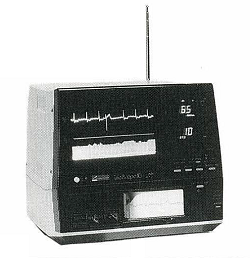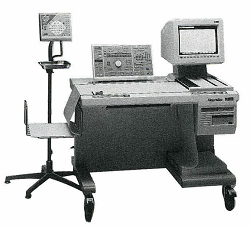This was a decade of worldwide expansion for Nihon Kohden, beginning with the establishment of Nihon Kohden America in 1979, followed by a European Representative Office in Amsterdam in 1981, Nihon Kohden Deutschland in Bad Homburg, Germany in 1983 and Nihon Kohden Europe in London in 1989.
In 1982, Nihon Kohden was listed on the 1st Section of the Tokyo Stock Exchange.
In 1989, Yoshio Ogino became chairman, and executive officer Kazuo Ogino became president.

A central computer provides around the clock ECG analysis to member hospitals, clinics, and physicians through the public telephone network. At its peak, 32 centers throughout Japan and 2,000 satellite ECG labs and offices were interpreting 1.5 million ECGs per year. This enormous database was used to develop the first generation Cardiofax interpretive ECG machines.

This was the world's first automatic EEG.

These were Japan's first radiolucent disposable electrodes.

This was the world's 1st ECG with built-in thermal dot recorder.

Arrhythmia detection was first developed by Nihon Kohden. This became a standard feature in all later monitors.

This was the world's first fetal monitor to use telemetry. Telemetry monitoring has always been a Nihon Kohden specialty. It was also used on our Life Scope 11 bedside and central monitors to eliminate cable congestion around the bed.

This was the world's first 3-channel simultaneous holter ECG recorder.

This was the world's first combined respiration monitor.

This multi-channel interpretive ECG was the world's first ECG with a large LCD screen so that the operator can check the waveform before recording, as well as easily view a variety of information.

EEG-4200/4300 electroencephalographs earned M.D. Buyline's SAMME award for best neurodiagnostics instrument in 1988.

This was Japan's 1st automatic hematology analyzer for veterinary use.

This was the world's first EEG with MO disk data storage. One MO disk could store roughly 50 hours of EEG, about 18,000 sheets of 300×345 mm Z-fold EEG paper. This provided great paper and space saving, as well as efficient searching and archiving of EEG records.
